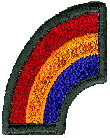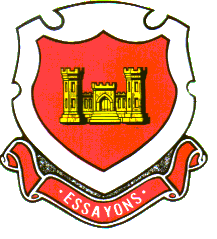
|

|
| LinkExchange Member | Free Home Pages at Tripod.Com |

The 104th Engineer Regiment was formed on 6 October 1917. The regiment was organized from the consolidation of the 1st Battalion New Jersey Engineers and the 2nd, 3rd, 4th and 5th New Jersey Infantry Regiments. Prior to the consolidation of the 1st Battalion, the New Jersey Engineers had units stationed at Newark, Camden, and Trenton, New Jersey. The 1st Battalion had been formed on 16 May 1917.
The 104th Engineer Regiment was called into Federal service on 20 June 1917, as a separate Engineer Battalion. On 15 September 1917, the battalion joined the 29th Infantry Division. The consolidation referred to above, took place while in Federal service to form the Regiment of Engineers in the old Square Division of World War I.
On 14 June 1918, the regiment moved to France as part of the Army Expeditionary Force's 29th Infantry Division. Arriving at Brest, the regiment saw service with the 29th Infantry Division at Moatz, Grandchamps, Coublanc, and Lafford. During the eleven months of AEF service, the battalions of the regiment operated in an attached status with the French Army's V Corps. General engineer support as well as combat engineer operations were provided to both the French Army and the United States First Army. On 11 May 1919, the regiment was sent home to Camp Dix, New Jersey, where it was mustered out of Federal service.
With the reorganization of the National Guard after World War I, the unit was designated as the 1st Battalion Engineers, New Jersey National Guard, on 11 July 1921. The battalion's headquarters was located at Englewood, New Jersey. During April 0f 1922, the battalion was again expanded and redesignated the 104th Engineer Regiment.
 With the war clouds over Europe, the regiment was again called
into service on 16 September 1940. Moving to Fort Dix, New Jersey, as part of
the 44th Infantry Division, the regiment arrived ahead of the main body of the
division to improve the camp. The regiment laid out and constructed an entire
Infantry Division Tent Camp. In addition to the division construction
mission, the regiment constructed the huge Fort Dix Reception Center to
receive draftees.
With the war clouds over Europe, the regiment was again called
into service on 16 September 1940. Moving to Fort Dix, New Jersey, as part of
the 44th Infantry Division, the regiment arrived ahead of the main body of the
division to improve the camp. The regiment laid out and constructed an entire
Infantry Division Tent Camp. In addition to the division construction
mission, the regiment constructed the huge Fort Dix Reception Center to
receive draftees.
The regiment, less the 2nd Battalion, was preparing to leave for the Carolina Maneuvers. Having just returned from maneuvers at A.P. Hill, Virginia, another reorganization took place. The 1st battalion was designated as the 104th Engineer Battalion, left the 44th Infantry Division, and was stationed at Camp Claiborne, Louisiana. From Camp Claiborned, the 2nd Battalion was designated the 177th Engineer Regiment (General Service), and was sent to the First U.S. Army area.
The new 104th Engineer Battalion moved to Fort Lewis, Washington. During their stay at Fort Lewis, the battalion was designated the 104th Combat Engineer Battalion and was given temporary duty status, and was attached to the Amphibian Training Force, Presidio, California. As a corps engineer battalion, they continued to train and moved to Fort Ord, California. The battalion joined the 7th Infantry Division by attachment on 5 May 1943. As part of the Amphibian Assault Force, the battalion sailed on the USS Josiah D. Whitney and LST 483 and LST 478. The 104th Engineers made the landings at the Aleutian Islands as part of the First Army's forces to engage the enemy in July 1943. After the fighting, the battalion was under the control of the Alaskan Defense Command and performed construction missions.
During this time, the old 2nd Battalion of the Regiment had been designated the 175th Engineer Regiment (General Service) and was stationed at Camp Pickett, Virginia. During late 1942, the 175th Regiment's 1st Battalion made the landings in North Africa. Arriving on the "Monticello", the 1st Battalion of the 175th entered Casablanca, Morocco. Early in 1943, the 1st Battalion moved to Tebessa Algeria, North Africa.
While the old 2nd Battalion (now the 1st Battalion 175th Engineer Regiment) was supporting combat operations in North Africa, the 104th Combat Engineer Battalion left the cold of Alaska for the sun of Oahu, Hawaii, in July 1943. Construction of housing and training areas for an Infantry Regimental Combat Team was completed at Koko Head, Hawaii.
In January 1944, the battalion made combat landings and provided engineer support in the Mandated Island Campaign of the Marshall Islands. After the invasion and assault, the battalion supported elements of the 4th Marine Division and contructed airfields on the islands for the U.S. Army Air Corps. The battalion then returned to Oahu, Hawaii.
While the 104th Engineer Combat Battalion was actively supporting the operations of the XXIV Corps in the Pacific, the 1st Battalion 175th Engineers was making landings in Sicily and Italy during 1944 and 1945. They supported the Fifth U.S. Army's fight up the Italian boot; Sicily, through Naples, Rome and the Po Valley.
After a rest in Hawaii, the battalion made the invasion of Leyte, Philippine Islands, in September 1944. After the invasion, the battalion stayed in the Philippines in general support of Army operations at Central Pacific Base Command.
In February 1945, the battalion was assigned to the Tenth U.S. Army and came under operational control of the XXIV Corps. The battalion would once again join their former friend, the 7th Infantry Division, for the invasion and assault on Easter Sunday morning, 1 April 1945, on the island of Okinawa.
The battalion stayed on Okinawa until the end of the war in the Pacific. Movement to, and occupation of Korea was next in line for units of the 104th Engineers. After a short period of duty in Korea, the battalion moved to the Philippines for movement to the United States. The battalion left Manila on 23 November 1945, on the USS Sea Barb. The battalion was inactivated at Camp Stoneman, California, on 8 December 1945.
At the same time the 104th Engineers were preparing to return home, the 1st Battalion, 175th Engineer Regiment (GS), had returned to the United States and was inactivated at Camp Patrick Henry, Virginia.
Once again the Engineers had returned home after Federal service to face a reorganization of the National Guard. The 1st Battalion, 175th Engineer Regiment, was designated as HQ and HQ Company, 104th Engineer Combat Group, on 9 July 1946. Company B of the old 175th became the 1407th Steel Treadway Company and Company C became the 184th Engineer Pontoon Company with a separate lineage of the 50th Engineer Pontoon Company. The 104th Engineer Combat Battalion became federally recognized on 30 December 1946, at Teaneck, New Jersey, and so began the peace-time organization of the 104th Engineers.
The battalion consisted of one company, HQ & Service Company, with a strength of three officers and thirteen enlisted. On 2 May 1947, the battalion was authorized to start recruiting for another company. During June 1947, the second company was formed as Company A, with two officers and eighteen enlisted.
 The battalion participated in its first post-war field training,
3 August through 9 August 1947, at Fort Dix, New Jersey. In December 1947,
Company B was formed with two officers and nineteen enlisted. Also in
December, the 104th Engineer Medical Company was authorized, with one officer
and four enlisted, and the battalion joined the 50th Armored Division as the
104th Armored Engineer Battalion. The HQ Company of the 50th Armored
Engineers became the battalion's Company C. The 1407th Treadway and the
184th Pontoon Company were part of the 104th Engineer Group. The battalion
and the group attended summer field training at Pine Camp, New York, for the
next two years. The 104th Group was disbanded and its HQ Company became
Company D of the 104th Engineer Battalion on 1 May 1949.
The battalion participated in its first post-war field training,
3 August through 9 August 1947, at Fort Dix, New Jersey. In December 1947,
Company B was formed with two officers and nineteen enlisted. Also in
December, the 104th Engineer Medical Company was authorized, with one officer
and four enlisted, and the battalion joined the 50th Armored Division as the
104th Armored Engineer Battalion. The HQ Company of the 50th Armored
Engineers became the battalion's Company C. The 1407th Treadway and the
184th Pontoon Company were part of the 104th Engineer Group. The battalion
and the group attended summer field training at Pine Camp, New York, for the
next two years. The 104th Group was disbanded and its HQ Company became
Company D of the 104th Engineer Battalion on 1 May 1949.
With the outbreak of the Korean War, the 150th Engineer Pontoon Bridge Company was ordered into Federal service, once again, on 19 August 1950, and departed for Fort campbell, Kentucky. The company trained at Fort Campbell and many of its personnel went to Korea as replacements. The unit returned to New Jersey in 1953.
During the Korean War, the battalion was again reorganized on 1 March 1951, to include personnel of the old 1407th Steel Treadway Company. The battalion now was organized as a HQ and HQ & Services Company, Companies A, B, C, D and the Bridge Company. From this point on, the battalion remained the same through several division reorganizations which changed its strength at times.
In October 1963, the battalion was one of the first New Jersey National Guard units, and one of the first in the United States, to go into what is now known as the Multi Unit Training Assembly (MUTA-4) weekend drill. The battalion trained during these MUTA-4 weekends at the New Jersey Military Academy, West Point, and Fort Dix, in direct support of active Army activities.
The battalion provided engineer mobility, counter-mobility and surviveability support to elements of the 50th Armored Division, with its line companies providing direct support to the division's maneuver brigades. The battalion also participated in many community projects, such as land clearing, bridge building, and the construction of ball fields. Members of the battalion were called to State Active Duty during severe weather emergencies, such as snow storms and floods, and cleared roads and evacuated people from flooded areas with their motorized rubber boats.
 The 104th Engineer Battalion was again reorganized on 1 September
1993 under the new Engineer Restructure Initiative (ERI) and was assigned to
the 42nd Infantry Division. Under ERI the battalion lost its D Company and
bridge company and retained its HQ and HQ Company, and Companies A, B, and C.
The battalion was again reorganized on 30 September 1994, and was officially
deactivated during a ceremony at the Teaneck armory on 6 November
1994.
The 104th Engineer Battalion was again reorganized on 1 September
1993 under the new Engineer Restructure Initiative (ERI) and was assigned to
the 42nd Infantry Division. Under ERI the battalion lost its D Company and
bridge company and retained its HQ and HQ Company, and Companies A, B, and C.
The battalion was again reorganized on 30 September 1994, and was officially
deactivated during a ceremony at the Teaneck armory on 6 November
1994.

Go to:
This page hosted by TRIPOD.COM
Get your own Free Home PageFind out Who's Where on the
Net
![]()